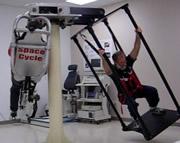 You spin me round: click here to see a video of the Space Cycle in action.© V. J. Caiozzo, Univ. California, Irvine.
You spin me round: click here to see a video of the Space Cycle in action.© V. J. Caiozzo, Univ. California, Irvine.Astronauts may soon have another weapon in the fight against the muscle-wasting effects of living in space. And it's a surprisingly low-tech one: a cycle-powered centrifuge that creates its own 'gravity'.
The contraption, called the Space Cycle, spins to create a force that mimics the pull of gravity. The device consists of a central spindle with a pair of attached harnesses, one of which has pedals that drive the machine's rotation.
As the cyclist pedals furiously, the centrifuge's spin throws the cages out and produces a force on the two occupants. The person sitting across from the cyclist can then perform exercises such as squats while 'weighted down' by the force of the rotation.
Mass production
“Even with onboard exercise, astronauts face the risk of losing muscle mass and function.”
Vincent Caiozzo
US National Space Biomedical Research Institute
The invention could be a simple solution to the problem of maintaining an astronaut's muscle bulk during long periods in space, such as stints on the International Space Station or a mission to Mars. Astronauts currently undergo a rigorous fitness regime when in space, but it is still difficult to mimic the effects of gravity, and long-term space passengers face losing up to 25% of their body muscle.
"Astronauts risk losing muscle mass and function because their muscles are not bearing enough weight," says Vincent Caiozzo, of the University of California, Irvine, a member of the team behind the Space Cycle. "It is important to find ways to increase load-bearing activity so astronauts can maintain strength."
The researchers have also been using the device to investigate the effects of different gravitational forces on muscle development. Participants undertake exercise at various levels of centrifugal force, after which their rates of muscle growth are evaluated. The study is part of a wider programme on space health run by the US National Space Biomedical Research Institute, in Houston, Texas.
Good spin
The idea of small centrifuges for astronauts is a hot topic, say Didier Schmidt and Oliver Angerer, members of the European Space Agency's life-science unit. Their group, based in Noordwijk, the Netherlands, is developing a similar centrifuge to test next year. More ground testing is needed to prove that centrifugation really does help bones and muscle, although its benefits for the circulation system are more clear.
Other teams are looking into devices that lower the pressure around an astronaut's lower extremities, helping to suck fluid into the lower limbs and giving the heart much needed exercise in pumping blood around the body.
Both kinds of device could potentially benefit the body even if the astronaut doesn't exercise inside. "What's important is to trigger the body's systems with short pulses of 'hypergravity'," says Schmidt.
ADVERTISEMENT
But for astronauts who are feeling energetic, the Space Cycle can be fitted with a range of exercise gizmos, including a treadmill or even another cycle, so that two spacefarers can pedal their way to fitness together.
Actually installing such devices on the International Space Station will require much further study and consideration. The presence of a spinning wheel inside a spacecraft can establish a small torque, which could potentially shunt it off course or put strain on the joints holding it together. Transporting and installing the Space Cycle is also such a complicated job that it may only be considered for future craft, says Schmidt.
To find out more about the study of astronaut physiology, subscribers can read our feature, 'Lie back and think of science'.
US National Space Biomedical Research Institute
